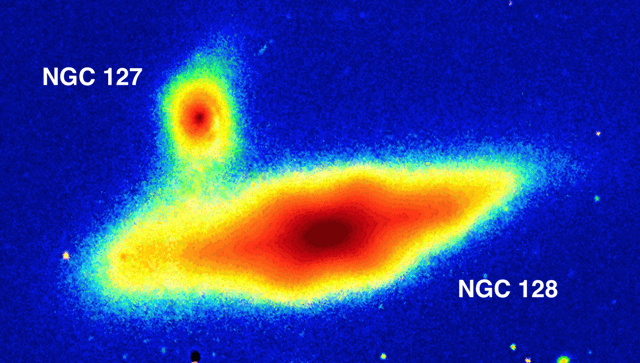May 6 2016
An abnormally shaped structure has been discovered in two nearby disc galaxies by a group of astronomers from the Swinburne University of Technology, Melbourne, using new imaging software developed by them.
 The large (peanut shell)-shaped bulge at the centre of the disc galaxy NGC 128. Credit: Sloan Digital Sky Survey / Aladin Sky Atlas / A.Graham, B.Ciambur (Swinburne University of Technology)
The large (peanut shell)-shaped bulge at the centre of the disc galaxy NGC 128. Credit: Sloan Digital Sky Survey / Aladin Sky Atlas / A.Graham, B.Ciambur (Swinburne University of Technology)
The Swinburne team observed a double “peanut shell shape” using its software. The distribution of stars that bulge from the centers of the disc galaxies - NGC 128 and NGC 2549 - forms this unusual shape.
The study findings have been presented in a paper reported in Monthly Notices of the Royal Astronomical Society.
The researchers used the data obtained from the Sloan Digital Sky Survey and Hubble Space Telescope, and they found that the two galaxies were simply exceptional. These galaxies are located at a distance of approximately 200 and 60 million light years, respectively, in the constellations of Pisces and Lynx. The peanut shell shape was observed at two individual layers in the 3D distribution of stars across the centers of the galaxies.
Ironically, these peanut-shaped structures are far from peanut-sized. They consist of billions of stars typically spanning up to a quarter of the length of the galaxies.
Alister Graham, Professor, Swinburne University of Technology
Although a single peanut shell configuration was already observed from the ‘bulges’ of these galaxies, the fainter second pattern had not been observed before in any galaxy.
They resemble two peanut shells, with one neatly nested within the other; this is the first time such a phenomenon has been observed. We expect the galaxies’ surprising anatomy will provide us with a unique view into their pasts. Deciphering their history can tell us about transformations that galaxies like our own Milky Way might experience.
Bogdan Ciambur, PhD student, Swinburne University
The bar-shaped star distribution that can be seen across the centers of several rotating galaxy discs is linked to the peanut shaped bulges by astronomers. Each of the two galaxies studied consist of two of these bars and one of the possible reasons could be due to bending of these bars of stars below and above the central disc of the galaxy.
The instability mechanism may be similar to water running through a garden hose: when the water pressure is low, the hose remains still (stars stay on their usual orbits), but when the pressure is high the hose starts to bend (stellar orbits bend outside of the disc plane). By directly comparing real galaxies with state-of-the-art simulations, we hope to better understand how galaxies evolve. The discovery is exciting because it will enable us to more fully test the growth of bars over time, including their lengths, rotation speeds, and periods of instability.
Bogdan Ciambur, PhD student, Swinburne University
The results of the study may also provide new insights into the peanut-shaped bulge of the Milky Way galaxy, which is believed to have two stellar bars in accordance with some astronomers.
Thankfully we are too distant from our Galaxy’s bulge to get caught up in the dizzying orbits that lead to these interesting peanut shell patterns. However, this is an ideal vantage point to study our Galaxy’s stellar bulge.
Alister Graham, Professor, Swinburne University of Technology